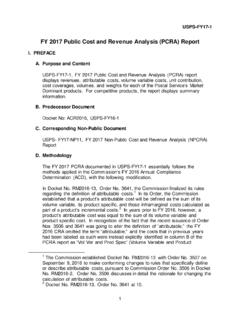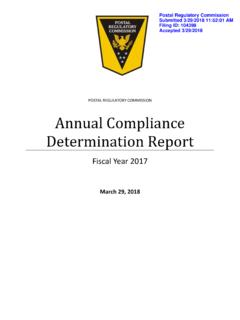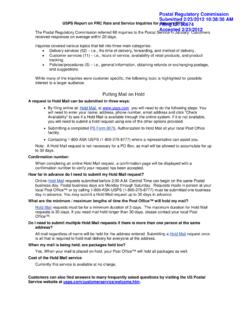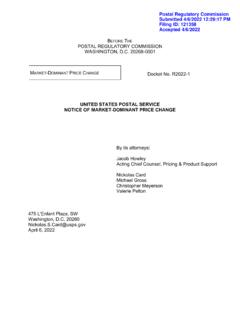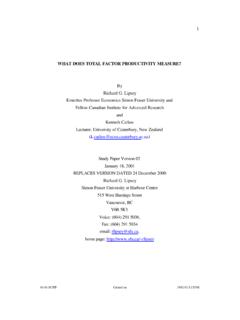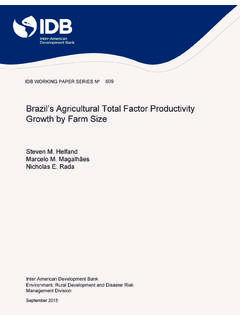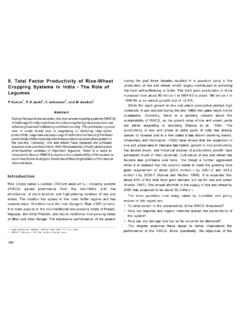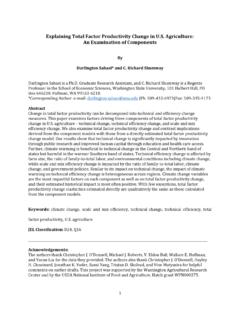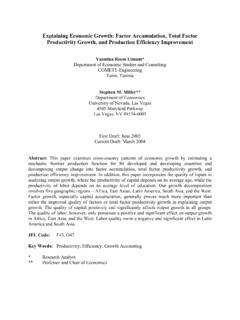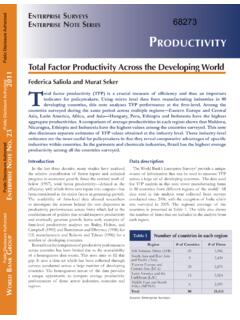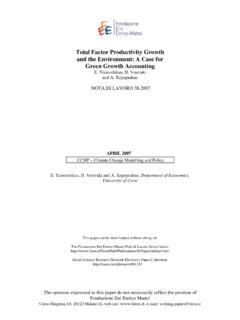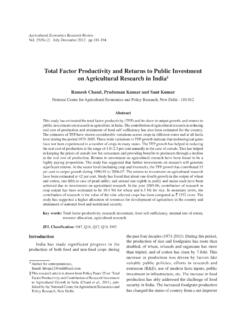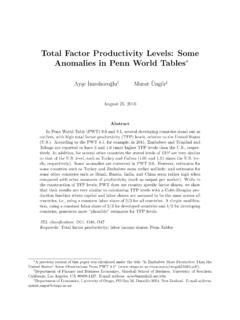Transcription of Total factor productivity final - prc.gov
1 Total factor productivity as a Measure of Operational Efficiency Christensen Associates 800 University Bay Drive, Suite 400 Madison, WI 53705 2299 March 20, 2017 Appendix D Postal Service March 20 Comments PRC Docket No. RM2017-3 Postal Regulatory CommissionSubmitted 3/20/2017 4:18:09 PMFiling ID: 99556 Accepted 3/20/2017 Christensen Associates Table of Contents EXECUTIVE SUMMARY .. 1 1 POSTAL SERVICE TFP METHODS .. 2 COMPARISON OF TFP WITH OTHER PROPOSED MEASURES OF OPERATIONAL EFFICIENCY .. 4 TFP DOES NOT UNCOVER THE SOURCES OF productivity IMPROVEMENT, NOR DOES IT INDICATE WHAT TFP INCREASES ARE ACHIEVABLE .. 5 INCREASES IN TFP LEAD TO COST REDUCTIONS, BUT NET INCOME IS AFFECTED BY VARIOUS OTHER factors BEYOND THE CONTROL OF THE POSTAL SERVICE .. 6 THE POSTAL SERVICE HAS INCREASED TFP AS VOLUMES HAVE DECLINED.
2 7 POSSIBILITIES FOR FUTURE TFP GAINS .. 9 CONCLUSION .. 9 Appendix D Postal Service March 20 Comments PRC Docket No. RM2017-3 1 Christensen Associates Total factor productivity as a Measure of Operational Efficiency EXECUTIVE SUMMARY The Postal Service retained Christensen Associates to provide an evaluation of Total factor productivity (TFP) as a measure of operational efficiency. In its Advance Notice of Proposed Rulemaking (Advance Notice), the Postal Regulatory Commission (PRC) lists various options for measuring operational efficiency, including TFP. 1 TFP is a comprehensive measure of operational efficiency. TFP is a measure that compares the level of workload (weighted mail volume, miscellaneous output, and delivery points) to the level of resource usage (all labor, materials, and capital used in the provision of those services).
3 TFP increases when workload increases more rapidly than resource usage increases, or when workload decreases less rapidly than resource usage decreases. In terms of considering the Postal Service s operational efficiency, TFP is a robust measure that fully captures the complexities of Postal Service workload and resource usage, as compared to real unit operating costs, workhours, and simpler productivity measures such as the number of pieces per workhour or the number of delivery points per workhour. While TFP is a comprehensive measure of operational efficiency, TFP does not determine the sources of productivity improvements, nor does it indicate what TFP increases are achievable. TFP is a top down measure of operational efficiency; it does not provide a benchmark that specifies the degree to which TFP can increase if best practices are adopted.
4 Furthermore, TFP in most industries has substantial year to year variations due to business cycles, the pattern of investment in new technologies, and strategic changes in business plans. When using TFP as an evaluation tool of management, it is important to look at TFP trends over several years rather than isolated annual TFP results. Furthermore, TFP is only one factor underlying trends in net income. TFP can increase in periods where net income decreases (and vice versa) because of other trends facing the Postal Service. One trend that has been important in recent years is the decline in mail volume, particularly among those products that have relatively high markups over their attributable costs. Postal Service TFP has increased substantially during the PAEA years even though the Postal Service suffered substantial losses.
5 On the other hand, TFP growth during the PAEA period lagged TFP growth immediately prior to PAEA, indicating that there is no evidence that PAEA led to greater productivity gains. The Alvarez and Marsal report2 identifies areas in which the Postal Service may achieve cost reductions. If the initiatives discussed in the report are successfully implemented, they will also increase Postal Service TFP. However, as Alvarez and Marsal note, improvements in many of these areas will require the cooperation of the Postal Service labor unions. INTRODUCTION Total factor productivity , sometimes called multifactor productivity , is a comprehensive measure of economic efficiency. The earliest Total factor productivity studies were designed to understand the 1 Postal Regulatory Commission, Advance Notice of Proposed Rulemaking on the Statutory Review of the System for Regulating Rates and Classes for Market Dominant Products, Docket No.
6 RM2017 3, Issued December 20, 2016, p. 4. 2 PRC Ten Tear Review Cost Efficiency Study, prepared by Alvarez and Marsal with the Institute for Supply Management, March 20, 2017. Appendix D Postal Service March 20 Comments PRC Docket No. RM2017-3 2 Christensen Associates sources of economic growth,3 but the scope of Total factor productivity (TFP) studies expanded to include the analysis of industry and company trends. Later, John Kendrick and Ephraim Sudit, among others, developed analytical frameworks that permit the analysis of company performance in terms of TFP. 4 In 1983, the United States Postal Service commissioned Christensen Associates to develop a measure of TFP that could be used to evaluate Postal Service performance. Under the direction of Professor Laurits R. Christensen, who had previously developed TFP measures for the railroad, airlines, and telecommunications industries, Christensen Associates developed a TFP measure applicable to the Postal Service.
7 This TFP measure relies on a variety of Postal Service data systems and a variety of public data sources. In 1985, the Postal Service adopted TFP as its productivity performance measure. The methods underlying the Postal Service TFP measure were published by Dianne Christensen, et The methods described in that paper have consistently been the basis for the TFP measure since its adoption. Over the years, the Postal Service has made changes to its data systems and there have been significant changes to the various public data systems. As these changes have occurred, the ways in which the TFP methods are implemented have changed accordingly, but the underlying conceptual framework has remained the same. In the following paragraphs, we describe the TFP methods. POSTAL SERVICE TFP METHODS Postal Service TFP is the ratio of Postal Service workload to Postal Service resource usage.
8 When Postal Service workload increases more rapidly than Postal Service resource usage increases (or when workload decreases less rapidly than resource usage decreases), TFP increases: in other words, TFP growth is positive. Recently, Postal Service TFP growth has been positive in most years since 2000, because the Postal Service has been able to substantially decrease resource usage. Workload has three components: weighted mail volume, miscellaneous output, and the size of the Postal Service network (measured by the number of delivery points). Weighted mail volume is an index that represents the amount of mail (the various types of letters, flats, and parcels) handed by the Postal Service. The weighted mail volume measure distinguishes 36 different Postal Service products. The number of different product lines in weighed mail volume is determined by the level of detail provided in the Revenue, Pieces, and Weight (RPW) reports, the Cost and Revenue Analysis (CRA) reports, and the International Cost and Revenue Analysis (ICRA) reports.
9 To obtain a weighted mail volume index, the number of pieces in each product group is weighted by the relative level of effort required to provide that product, as measured by the CRA and ICRA. For example, if the cost per piece for one product group is twice as great as the cost per piece for a second product group, then each piece in the first product group is ascribed twice as much weight as each piece in the second product group. 3 Some examples of these early Total factor productivity studies include Moses Abramovitz, Resource and Output Trends in the United States Since 1870, American Economic Review, Vol. 46, No. 2 (1956), pp. 762 782; Robert M. Solow, Technical Change and the Aggregate productivity Function, Review of Economics and Statistics, Vol.
10 39, No. 3 (1957), pp. 312 320; and Dale W. Jorgenson and Zvi Griliches, The Explanation of productivity Change, Review of Economic Studies, Vol. 34, No. 3 (1967), pp. 249 280. 4 See John W. Kendrick, Improving Company productivity : Handbook with Case Studies (Johns Hopkins University Press, 1984); and Ephraim F. Sudit, productivity Based Management, (Kluwer Nijhoff, 1984). 5 Dianne C. Christensen, Laurits R. Christensen, Charles E. Guy, and Donald J. O Hara, Postal Service productivity : Measurement and Performance, in Michael A. Crew and Paul F. Kleindorfer, eds., Regulation and the Nature of Postal and Delivery Services, (Kluwer Academic Publishers, 1993), pp. 237 255. Appendix D Postal Service March 20 Comments PRC Docket No. RM2017-3 3 Christensen Associates Miscellaneous Output is a comprehensive measure of the other services provided by the Postal Service.

